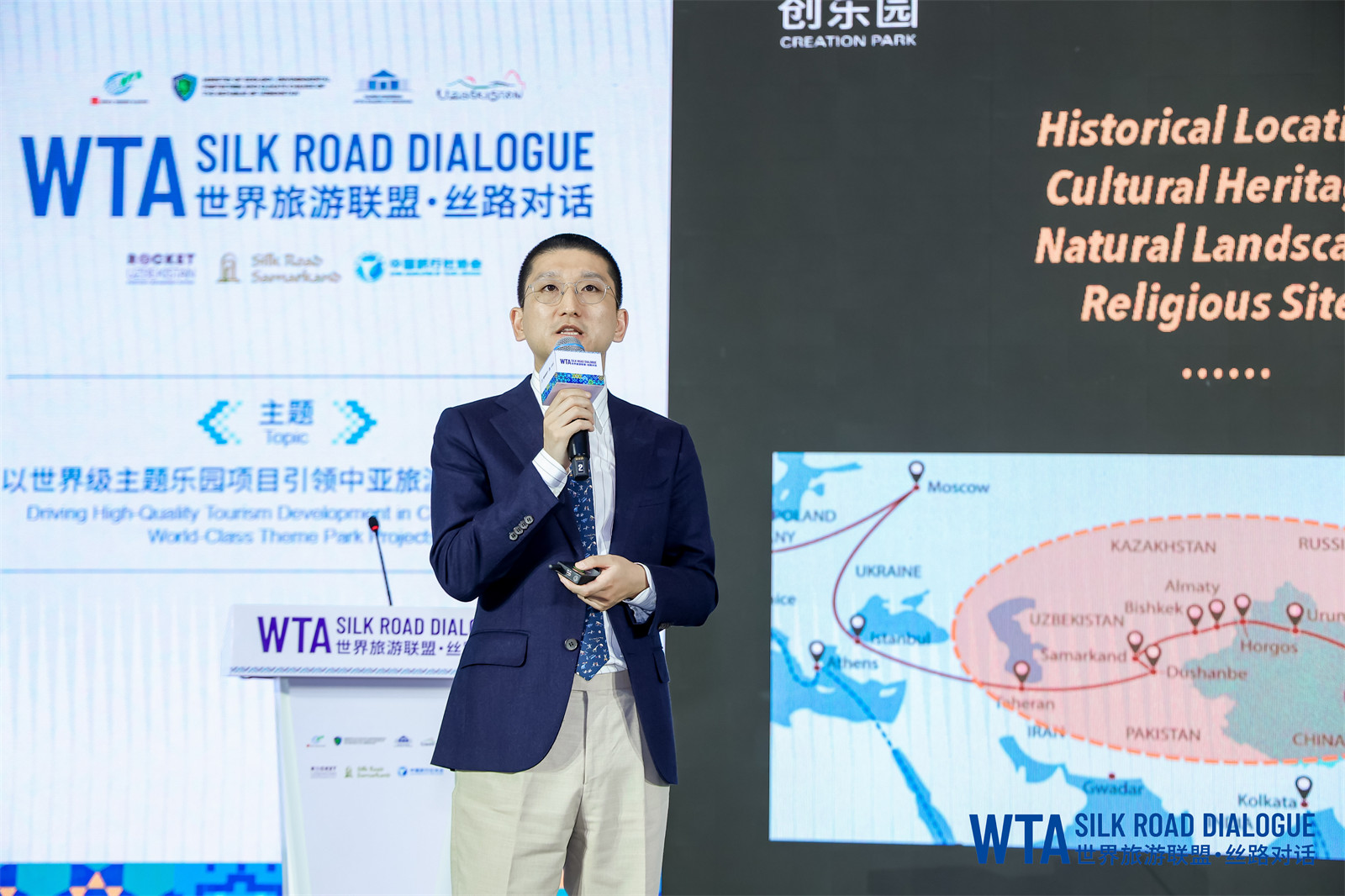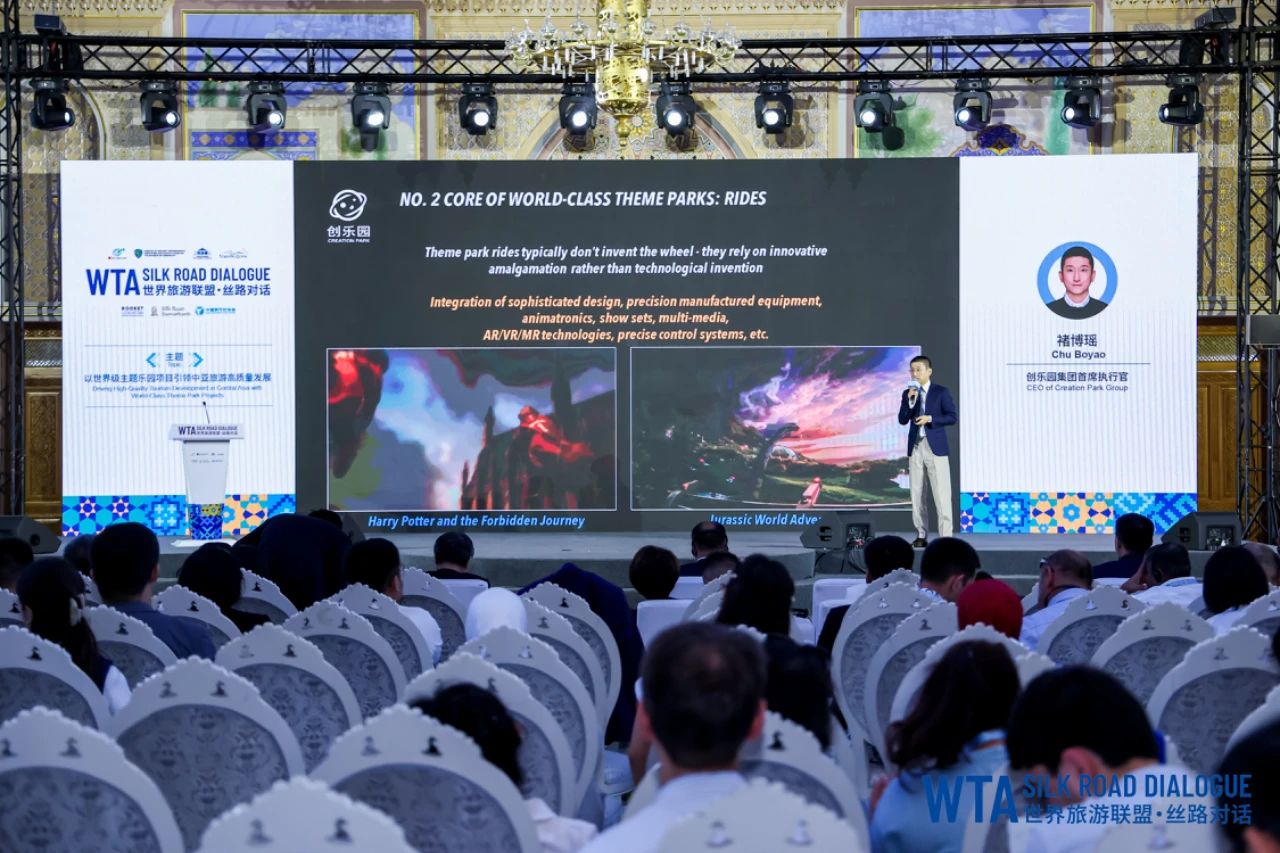2025-07-11
On July 3 (local time), the WTA·Silk Road Dialogue was held in Samarkand, Uzbekistan. Chu Boyao, CEO of Creation Park Group, delivered a keynote speech titled "Driving High-Quality Tourism Development in Central Asia with World-Class Theme Park Projects". Here are key takeaways from the speech:

It is truly an honor to return to the beautiful city of Samarkand. After my team’s first visit to Uzbekistan this past February, we spent months reflecting on an important question: Given our commitment to creating world-class theme parks, does Central Asia—particularly Uzbekistan, with its rich historical and cultural heritage—present the right opportunity? Today, I’m privileged to share our insights.
As an avid traveler with a deep passion for Silk Road Tourism, I’ve had the privilege of exploring numerous cities and destinations across China and Central Asia. While many of the attractions along the Silk Road highlight rich historical heritage and stunning natural landscapes, there is an increasing demand, particularly among younger travelers and international tourists, for world-class theme park experiences.
So, what defines a theme park? Simply put, it is an immersive experience system centered on visitor engagement, built upon globally renowned IP, and blending local culture, creativity, technology, engineering, and entertainment operations.
World-class theme parks stand out in three key areas:
1. Masterful Storytelling. Take Transformers, an IP that originated from Paramount Pictures films and Hasbro toys. Its adaptation into a Dark Ride hinges on creative narrative compression—condensing films, stories, or historical figures into minutes of themed entertainment or short performances. Generally, we prioritize universal themes, like family-friendly adventures, heroism, and personal growth, over romance or war. These narratives must blend seamlessly with cutting-edge rides and performances, all brought to life through innovative creative direction.
2. Innovative Integration & Design. To borrow an analogy from automotive design: we don’t reinvent the wheel or chase after pure tech breakthroughs. Instead, we curate: merging complex design, precision engineering, automation, theatrical staging, multimedia, and emerging AR/VR/MR technologies into compact, immersive experiences. These systems require meticulous control and synchronization, which is evident in the rides and shows that audiences love and remember.
3. Spectacle as the Heartbeat. Theme park "shows" transcend traditional theater. They leverage large-scale effects, stunts, themed sets, and animatronic figures to deliver high-intensity, escapist thrills. For instance, How to Train Your Dragon’s "Toothless" can electrify audiences in just 10–15 minutes.
The development of China’s theme park industry can be broken down into four distinct phases. Before 2011, China’s theme park landscape was limited to basic amusement parks, featuring relatively simple storytelling and performance elements. A major turning point came in 2011, when Shanghai Disneyland opened its doors, bringing the first world-class theme park experience to mainland China. Developed by Walt Disney Imagineering, this project remains one of the most successful theme park ventures in the Chinese market to date. In 2016, the industry took another giant leap forward with the opening of Beijing Universal Studios, a collaboration between our team and Universal’s. This world-class project was pivotal in refining our understanding of the core principles behind successful theme park development. Since 2021, China’s theme park sector has entered a period of dynamic growth. We’re now witnessing increasingly sophisticated offerings and a maturing industrial ecosystem. During this phase, specialized, high-quality partners—from law firms and investment banks to creative agencies, ride manufacturers, construction teams, and specialized subcontractors—have emerged, forming a comprehensive industrial support system tailored to the unique needs of China’s theme park market.
The economic impact of theme park development can be seen in both internal and external dimensions. Internally, theme parks serve as the "crown jewel" of the tourism market. They generate significant clustering effects through various formats, including theme parks, water parks, themed resort hotels, and retail-entertainment complexes. The integrated development of transportation infrastructure and supporting facilities within and around the parks further amplifies their economic benefits, creating a thriving local economy. Externally, theme parks produce impressive spillover and multiplier effects. Investments in municipal and transportation infrastructure stimulate growth in surrounding sectors such as hospitality, dining, and entertainment, ultimately creating sustainable tax revenue streams. Perhaps most importantly, high-quality content delivered through immersive entertainment formats becomes a powerful tool for cultural expression. This not only promotes national pride but also strengthens cultural identity, fostering a deeper connection among citizens.
Over the past few months, my team and I have worked on developing a concept for a world-class theme park in Central Asia, and we’ve drawn several key insights: Geographically, this theme park has the potential to become a regional tourism hub, a must-visit destination for young travelers, attracting visitors from Central Asia, East Asia, Central and Eastern Europe, and the Middle East. Demographically, with carefully chosen IP content, it can appeal to a wide range of audiences, from students and couples to families, making it a versatile attraction for all age groups. Thematically, the park will blend internationally renowned IPs with local cultural elements, crafting a unique experience tailored specifically to Uzbekistan. In terms of scale, we envision a 25-hectare park with 5-6 themed zones and over 20 world-class attractions, all designed with cutting-edge technology. Financially, we project an annual attendance of around 3 million visitors, with an average spend of $60 per person.
Let me give you a concrete example: our proposed "Observatory Night Adventure" at the Ulugh Beg Observatory, located northeast of Samarkand. This attraction features a 360-degree rotating 4D dome theater, equipped with cutting-edge spherical screen technology, and can accommodate 750 guests per hour. The story follows Kuski, Ulugh Beg’s son-in-law, who joins ZHENG He’s fleet to Beijing. As he masters celestial navigation and divination, he learns to predict cosmic cycles and climate patterns. Upon his return to Samarkand, Kuski discovers that local sorcerers are besieging Ulugh Beg at the observatory. To save him, Kuski sneaks into the observatory at night, unfurling star charts and using Chinese astrological instruments in a dramatic intellectual showdown under the stars. Like all our attractions, this experience provides just the beginning of the story, inviting visitors to engage their imaginations. Through our “storyboard” creative process, we develop 8-12 such storylines for each attraction, carefully crafting compelling narratives that evolve beyond the initial experience.

A complete theme park project involves over 60 modules across five major phases: preliminary planning, creative design, construction management, pre-opening preparations, and post-opening operations. Our team specializes in providing full lifecycle professional services for theme park development. We look forward to collaborating with partners to create landmark tourism destinations that blend global vision with local relevance, using creativity and technology to deliver next-generation themed entertainment experiences.